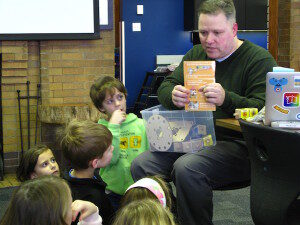This is a cross-post from the Tynker Blog:
In our new blog series, we feature Tynker Teachers who are moving coding forward in their school district.
This week, we’d like you to meet Illinois educator Todd Burleson. Todd is excited about Tynker and coding and recently shared his love for drone programming at the Illinois Computing Educators Conference, one of Illinois’ largest ed tech conferences.
So, Todd, who are you, and what do you teach?
I’ve been an educator for 24 years, teaching kindergarten to college-age students. I’m currently the Library Media Specialist at Hubbard Woods Elementary School in Winnetka, IL where I work with Kindergarten through fourth-grade students. I’m a passionate teacher-maker-librarian always striving to find just the right balance of books and bytes and igniting the imagination to explore both. My biggest honor was being chosen as the 2016 School Library Journal School Librarian of the Year.
Your excitement about drones and programming is infectious. What is it about programming drones that get you so excited?
I have had a lifelong fascination with flight. I dreamed of being a pilot in the military, but color blindness foiled that plan. It probably started by growing up at Wright-Patterson Air Force Base in Dayton, Ohio. The Wright Brothers famously designed and improved their flying machine there. I spent days at the Air Force Museum of flight dreaming of flying myself one day. Remote control helicopters, planes and now quadcopters have gotten me pretty close. Now that you can fly with a live camera feed streaming to your iPad or phone, I feel like I’m on board. I do hope to one day earn my pilot’s license. For now, however, I am excited to learn to program quadcopters. I think there is such a difference when kids ‘program’ a drone as opposed to simply flying. What typically happens when anyone, me included, starts out ‘flying’ a drone, they crash. By using a block coding app like Tynker, it slows down the process and teaches users to think through each step of a flight. This is a great metaphor for life and will result in a lot longer lifespan for drones too!
The “connected toy” movement seems to be growing. Where do you envision this movement going?
I think that ‘connected toys’ have tremendous potential for good. Toys that can read and respond to user’s facial expressions and words can go a long way toward teaching and be develop empathy. I think that a toy like Cognitoy takes away some of the obstacles for young children to research and technology by allowing users to simply talk to it.  The cute and friendly dinosaur has a ‘Grover-like’ voice that makes me happy to hear it talk. It can tell and create stories with children. It can answer questions and it develops a unique personality. It’s not designed for adults, but I would love one. It’s like an Alexa for kids.
The cute and friendly dinosaur has a ‘Grover-like’ voice that makes me happy to hear it talk. It can tell and create stories with children. It can answer questions and it develops a unique personality. It’s not designed for adults, but I would love one. It’s like an Alexa for kids.
A growth mindset is a big deal these days. Do you see growth mindset behavior from your students? What does that look or sound like?
The key word around growth mindset is resilience. I see that when it comes to learning to code. Even our youngest learners understand the concept of block coding. When students struggle and eventually succeed, they realize that problem-solving, while challenging, isn’t insurmountable. Failure is just evidence of trying. This is something we say over and over in our school. We want kids to know that iteration is simply part of the process. In our school, it is kids successfully learning to code a robot through a maze or deliver a Lego minifig to from a home base to a landing pad.

What other kinds of toys would you like students to be able to program?
I start my youngest coders with tools like KIBO and Beebot/Bluebot. These two tools teach sequencing and have a physical component to the actual coding. By connecting the wooden blocks for KIBO and pressing the forward, left, right and backward buttons on Beebot/Bluebot, students realize that they can totally control the movements of the robot.


This builds familiarity and confidence and leads to more complex block coding with devices such as Dot and Dash, Sphero, and my favorite, Parrot Minidrones.



How do we get STEM and coding into the core classes? What’s your strategy for making coding an everyday skill?
The first step is to breed familiarity with the tools. When kids can get over the hurdle of the basics, they can begin to think beyond simple coding projects. There is always a bit of resistance from educators because we often feel that we have to have mastery of the tools we use in education. For me, I’ve embraced the idea that kids will probably ‘get’ the programming faster than I do. In fact, I turn that around and have them teach, support and encourage one another. If teachers can be brave enough to let kids lead, I think it will help get coding into the typical classroom. I also think that as technology educators, we have to create opportunities to collaborate with teachers. Being willing to spearhead a project with a class that is eager can be a tremendous opportunity. When teachers ask if I can help them integrate technology into their class, I always answer, “Yes, and…” That’s where the magic happens, in the “and…” It is where we all grow, stretch, and extend our learning.
